Last Updated on February 14, 2021
Disclosure: This is a sponsored post which we have received a free product from One Degree Organics. However, I review, make recipes, and introduce ONLY the products that I truly support, use, and believe that are good for us!
Do you like savory pancakes? Okonomiyaki (Japanese Savory Pancakes) is a typical Japanese dish using relatively inexpensive ingredients such as flour and green cabbage. My recipe is vegan and made with spelt flour for more intake of whole grain and fiber that helps to boost your health and easy digestion! It is very easy to make and tastes just as good as the traditional one!
What is Okonomiyaki?
Okonomiyaki [お好み焼き] can be translated as “fry as you like.” It was originally a regional food developed in western Japan prefectures, namely Osaka and Hiroshima. Now it is widely eaten all over the country in many different variations. Each region represents a different style of okonomiyaki using different ingredients and methods however the basics ingredients remains the same.
Some of the common ingredients (mostly not vegan) for okonomiyaki batter are:
- all-purpose flour
- water (or dashi stock)
- egg
- grated mountain yam
- green cabbage
- scallions
- tempura batter crunchy bits
- pork
- squid
For the toppings you may see:
- Japanese Worcestershire sauce
- Japanese mayo
- bonito flakes
- beni-shoga (Japanese red pickled ginger)
- aonori (Japanese green seaweed)
- Japanese shichimi pepper
As you can see, so many common ingredients are not vegan friendly. The good news is you can leave those completely out but still make a vegan okonomiyaki using some substitutes. For me, it still tastes just as delicious or even better!
Organic Sprouted Spelt Flour
As you may know, I value very much on eating organic food. That also means, knowing the sources of ingredients and the productions are inseparable to how I would like to eat.
For this recipe, I made it with Organic Sprouted Spelt Flour from One Degree Organics to give a little healthy twist!
One Degree Organics is an organic brand (as the name says it all), all products are always non-GMO and also verified by the Non-GMO project. Their products are also certified as Glyphosate Residue Free and display the Bio-Checked Non Glyphosate Certified seal. They use third-party testing to confirm the absence of this pesticide, which The World Health Organization classifies as a “probable carcinogen,” or cancer-causing substance.
What I really like is the fact that One Degree Organics is a leading company promised in 100% food transparency. They are committed to provide clean foods which means the source of every single ingredient that goes into their product is from organic farmers who uses only plant-based farming methods! As vegans also as consumers, it is good to know that we can trust these farmers.
For them to provide high quality organic products, the members of the One Degree family travel near and far to personally meet and interview the farmers and producers face to face and learn about how they grow and process their food.
I have tried their cereals (Cacao O’s is my absolute favorite), granolas, instant oats products, rolled oats, bread, and flour. I can honestly say all of them are great in taste, health, and quality!
The Ingredients
Here is the list of ingredients to make this delicious savory pancakes!
Making beni-shoga (Japanese red pickled ginger)
- Ginger
- Ume Plum Vinegar (Rice Vinegar + Salt as a substitute)
The Batter
- Spelt Flour or all-purpose flour as a substitute
- Water
- Mountain Yam (optional but highly recommended)
- Dulse Flakes (optional but recommended)
- Salt
- Green Cabbage
The Rest
- Neutral Oil (I used Sunflower Oil)
- Soy Sauce (Tamari or Pouzu as a substitute)
Toppings
- Vegan Mayo
- Aonori (highly recommended) *see the tips blow
- beni-shoga (store bought or homemade) *see the tips below
- Japanese shichimi pepper flakes (optional)
You may be intimidated by some ingredients on the list above. No worries! I can help you with it!
The Tips and Recipe Notes
This should help you to guide through some unfamiliar things on the ingredients list and more!
Beni-Shoga
You may never heard about beni-shoga [紅しょうが] which is Japanese red pickled ginger. It is similar to pickled ginger that comes with sushi but it is not sweet and has a color of red. In my opinion, this is a must ingredient for okonomiyaki. I bought mine from Gold Mine Natural Foods. It is vegan friendly.
You may be able to find some at your local Asian grocery stores or other online stores. Make sure to check the ingredients! Most of them contain red #40 which is not vegan as you may know. Now, if you have no luck finding one, you can make something similar on your own! It is super EASY!
I tested this for those who have no access to beni-shoga. The goal is to make salty and acidic taste ginger strips so you have two options.
- Ginger and Ume Plum Vinegar or
- Ginger and Rive Vinegar + Salt
The option 1 tastes closer to the real deal. Since the ume plum vinegar has a natural red color from red shiso perilla leaves, it gives a slight red color and the aroma of shiso leaves to the ginger. In the U.S., you can find ume plum vinegar from Wholefoods Market, Eden Foods or Gold Mine Natural Foods.
On the other hand, the option 2 does not have any color or additional aroma. However, it gives enough saltiness and acidity that we need. It is more accessible. I am pretty sure that rice vinegar is widely available!
Either method, just let the ginger “pickled” for 20 minutes or so (while pancakes are being cooked) then it is ready!
Flour
Although, this recipe features spelt flour as a healthier option, regular all-purpose flour is typically used to make traditional okonomiyaki. Feel free to try both versions. Honestly, I like both of them equally! You may want to change the amount of water if using all-purpose flour (see the tip below.)
Water
In my experience, spelt flour tends to be a little runny compare to all-purpose flour. So I use less water than I typically do with the regular flour. It is safe to follow this ratio.
- Spelt Flour to Water [1:1.5]
- All-Purpose Flour to Water [1:2]
Mountain Yam
I understand that you may not find mountain yam easily although any Asian store should carry them. Grated mountain yam gives some fluffiness to the texture. It is highly recommended however it can be made without.
You peel the skin and fine grate it using any grater you have. It is very slimy so please be careful when you grate it! It will be safer if you leave some skin on for a better grip.
When you add the grated mountain yam, the batter gets slightly thicker because it acts kind as an biding agent as well. However, the mountain yam also has some water contents so you do not need too much otherwise the batter may not set well. You can aim for the quarter of the amount of the flour after being grated. I would recommend cutting a bit larger than what you need, and after peeling and grating, measure it to be a quarter.
Consistency of the Batter
Okonomiyaki batter should not be too loose nor to thick. Look for something like waffle batter without lumps. Make sure to mix well! Also, remember that cabbage releases its water content as it is getting cooked. If anything, aim for thick consistency rather than loose.
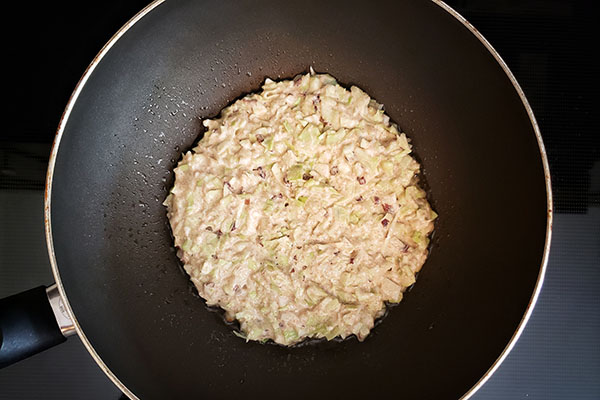 |
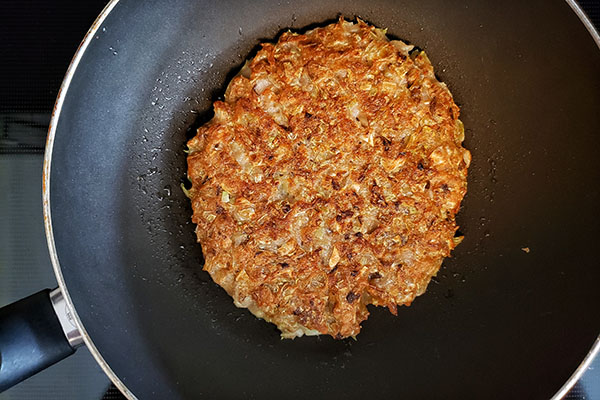 |
Aonori
This is another ingredient you really want to use as topping. Aonori [青海苔], pronounced as “ah-o-nori” is Japanese green edible seaweed.
It tastes more intense and aromatic than nori seaweed that most people are familiar with for making sushi. While you can get it on amazon, you may be able to replace with regular sushi nori. I must say it will NOT taste the same but it definitely adds something. Just tear a nori sheet with hands and make it into smaller pieces or shredded with scissors. Nothing fancy here!
Feeling Inspired?
Check out other delicious Japanese vegan recipes!
Sautéed Asparagus with Lime Soy Sauce
Okonomiyaki (Japanese Savory Pancakes)
Ingredients
Making beni-shoga (Japanese red pickled ginger)
- 2- inch ginger knob peeled and julienned
- 2 tbsp ume plum vinegar or substitute with 2 tbsp rice vinegar + 1 tsp salt
The Batter
- 1 cup spelt flour (I used Organic Spouted Spelt Flour from One Degree Organics) or all-purpose flour for a substitute
- 1 1/2 cup water use more if using all-purpose flour *
- 5 oz mountain yam peeled and grated (optional ingredient but highly recommended)
- 1 tbsp dulse flakes (optional but recommended)
- 1/2 tsp salt
- 1 green cabbage finely chopped or shredded
The Rest
- 2 tbsp + 2 tsp neutral oil (2 tsp for 6-inch pancake)
- 2 tbsp + 2 tsp soy sauce (2 tsp per 6-inch pancake) *
Toppings
- vegan mayo
- aonori (highly recommended) *
- beni-shoga (store bought or homemade) *
- Japanese shichimi pepper flakes (optional)
Instructions
- Make beni-shoga (if you have a store bought one skip to step 2.) In a small prep bowl, combine ginger and ume plum vinegar (or rice vinegar + salt as a substitute.) Mix and let it stand for at least 20 minutes or until serving pancakes. Set aside.
- Make the batter. In a large bowl, add spelt flour and pour water. Use a whisk to mix until seeing no lumps. Next, add grated mountain yam (optional), dulse flakes and salt. Mix until blended. Lastly, add cabbage to the batter. Mix again until all ingredients are combined. The batter should not be too loose nor too thick (similar to waffle batter.)
- Heat up a non-stick pan or something similar at medium heat. Pour 2 tsp neutral oil and add a 1/4 of the batter. Spread out to make about 1-inch-thick round. Cook for 8-10 minutes. Watch the heat to avoid burning.
- Flip the pancake. Use a pancake spatula to flat it by adding gentle pressure. Cook for another 8-10 minutes.
- Flip again and pour 2 tsp soy sauce over the pancake. Remove from the heat. Repeat the process.
- Serve immediately with vegan mayo, aonori, beni-shoga and shichimi pepper on top.
Notes
- It’s best to eat while it’s very hot. I recommend making another one while eating one.
- Any leftovers can be stored in fridge for 2-3 days. Reheat in a pan.
- If you use all-purpose flour, you may increase the amount of water up to 2 cups/480 ml. Start with 1 1/2 cups and add little by little until the batter is not too thick nor too runny.
- For the sauce, tamari or ponzu sauce (it adds some citrusy tanginess) can be used as a substitute to soy sauce.
- Aonori is highly recommended for making it authentic. You could use shredded nori or teared nori sheet as a substitution although it does not give the same flavor.
- Beni-shoga is a must ingredient for the authentic taste. If you can’t find good quality beni-shoga, it is better to make one on your own (see the recipe above.) A lot of them contains “food color #40” so make sure to check the ingredients!
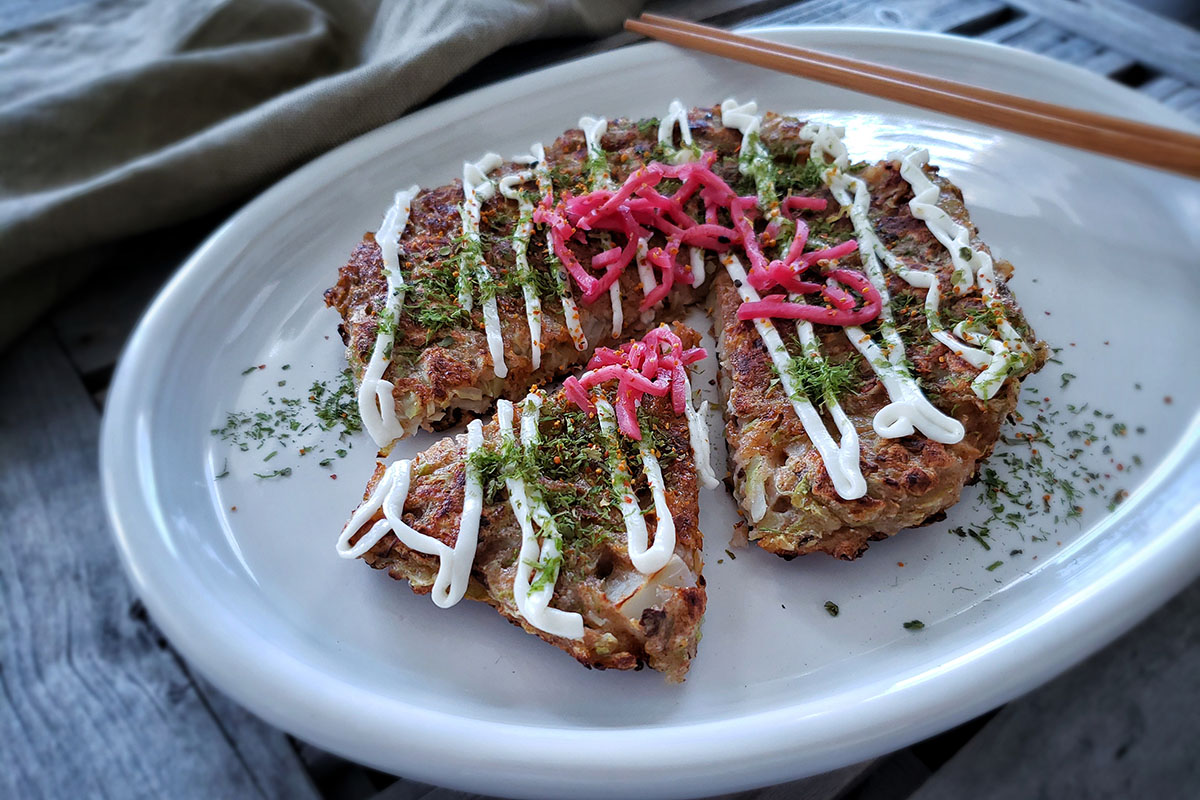
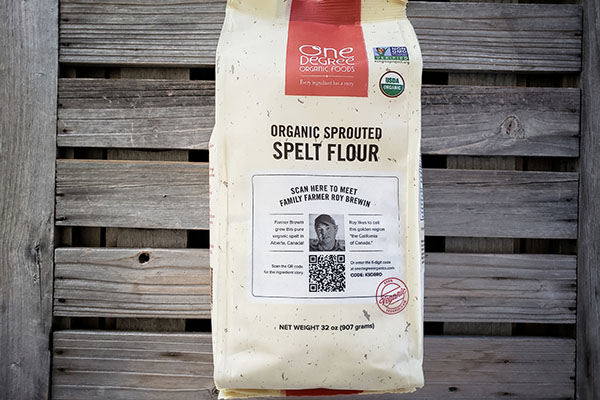
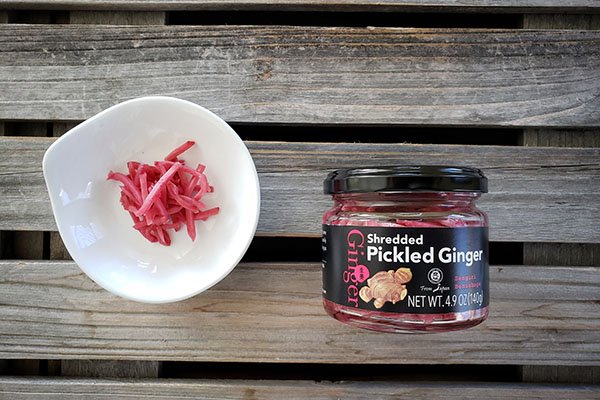
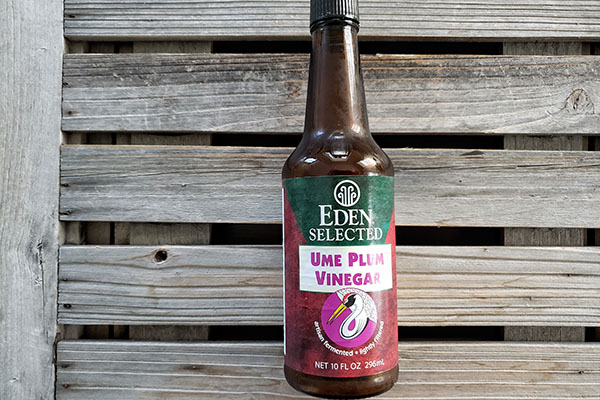
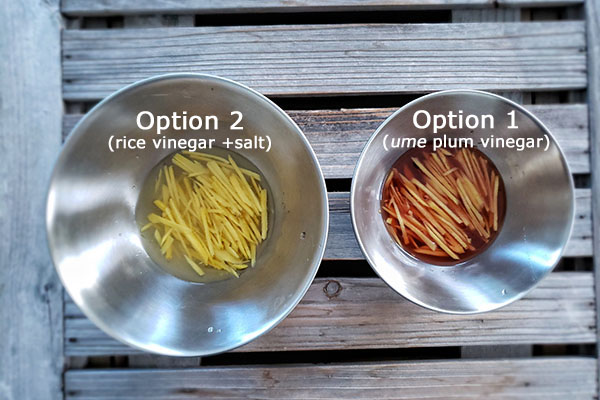
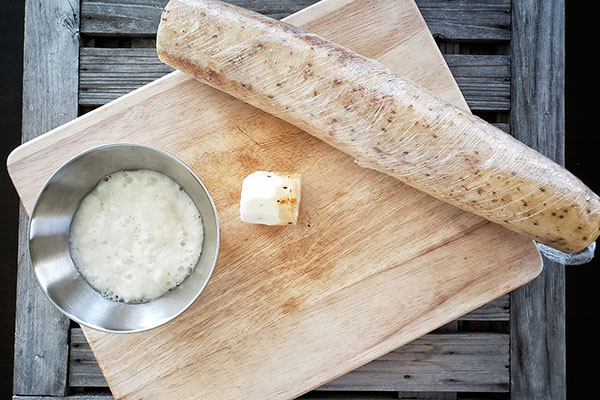
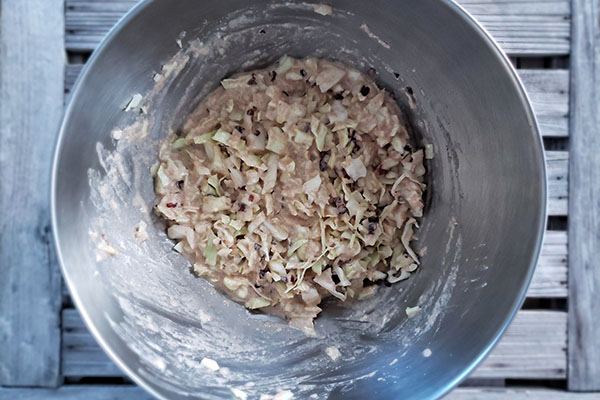
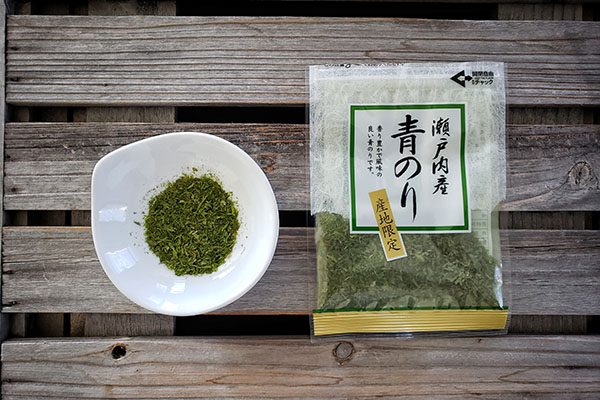
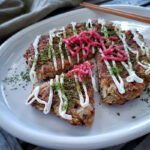
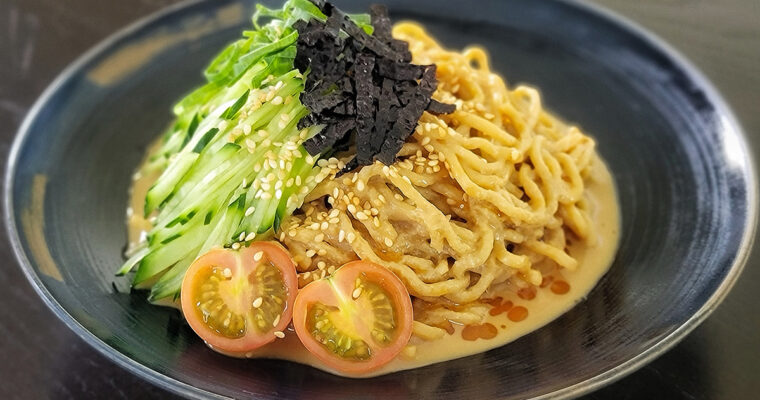
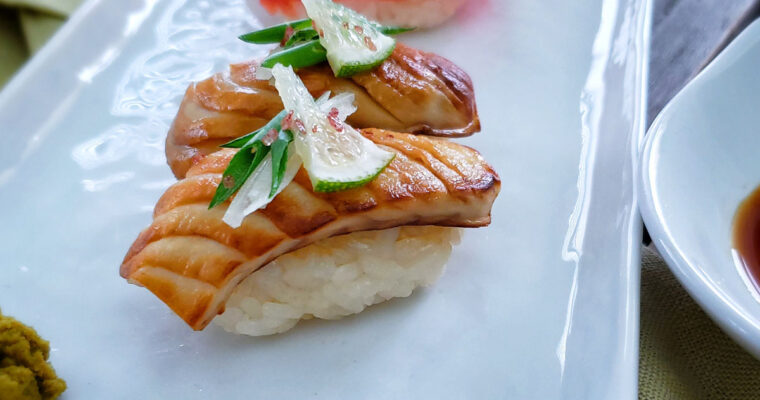

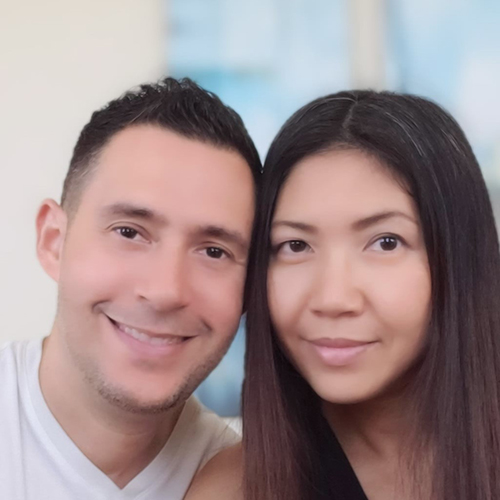
![LINGUINE WITH KALE & LEMON CAPER SAUCE
[ケール、レモン、ケイパーのリングイネ(ヴィーガン)]
By @plantbased_matters
Recipe at plantbasedmatters.net
Here is one of my best vegan pasta creations!
Linguine with Kale & Lemon Caper Sauce is a lemon-aroma-filled light pasta with kale and capers. Don't you love the combination of lemon and capers?
If you're new here, you may think I'm all Japanese/Asian food, but my non-Asian pasta recipes are hidden gems of my recipe collections 🤣 I can't believe how good the Linguine with Kale & Lemon Caper Sauce tastes especially with a drizzle of Meyer Lemon Olive Oil.
Enjoy!](https://plantbasedmatters.net/wp-content/plugins/instagram-feed/img/placeholder.png)